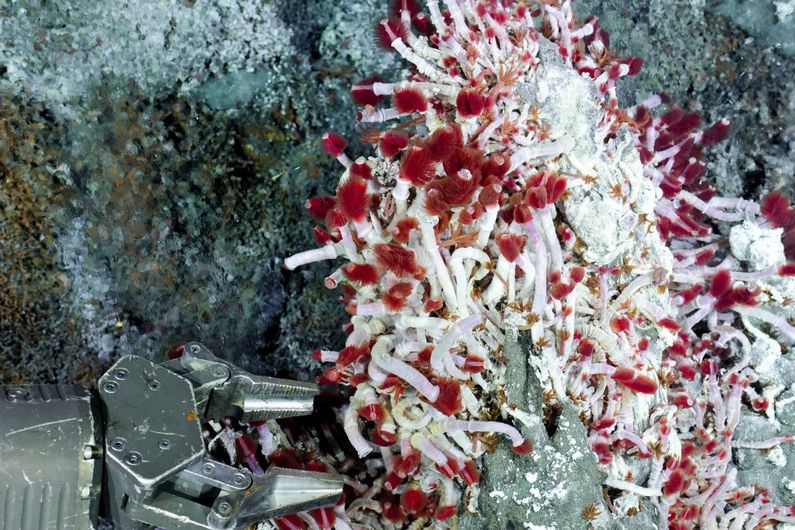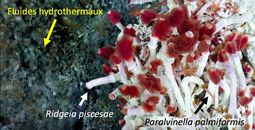How do marine worms adapt to deep-sea conditions?
- UdeMNouvelles
10/11/2023
- Martin LaSalle
DNA sequencing of marine worms has revealed how they adapt to life 2,500 metres below the ocean’s surface, where they experience extreme pressure conditions and temperature fluctuations.
Maeva Perez is fascinated by marine worms. Her first encounter with these cold-blooded invertebrates dates back to her time at the University of Victoria, in British Columbia, where she was completing a master’s in biology. Her thesis was on the symbiotic relationship between a species of marine worm and the bacteria in its environment that helped the worm adapt to a seemingly inhospitable ecosystem at the bottom of the Pacific Ocean.
Perez's fascination grew at Université de Montréal, where she recently completed a doctorate in the laboratory of Bernard Angers, a professor in the Department of Biological Sciences with whom Perez had previously interned. But before delving deeper into this family of annelid worms (from the Latin annelida, or “little ring"), Perez wanted to know a little more about their genetics.
2,500 metres below sea-level
Deep-sea annelid worms live in total darkness near hydrothermal vents some 2,500 metres below the surface, in an environment where the pressure is 300 times greater than at the surface and the temperature varies between 60°C and 2°C.
They were discovered in the early 1900s during a seafloor-scraping expedition but it was not until 1977 that they were first seen in the East Pacific Rise, where water in the Earth’s crust is heated by magma and shoots up through thermal vents at a temperature of 300°C.
“The worms play a very important ecological role in their ecosystems,” Perez said. “They create new habitats and allow other species to move in. Deep-sea ecosystems are currently threatened by underwater mining ventures, so there’s an urgent need to better understand their ecology, evolution and resilience to human impacts.”
Epigenetics plays a role
Having studied the worms’ symbiosis with bacteria in detail, Perez is now investigating how epigenetics influences the ability of marine worms to adapt.
“The role of epigenetics in species evolution and resilience is getting a lot of scientific attention right now,” said Perez. “Epigenetics looks at all of the processes involved in gene expression, or non-expression. If you think of a genome as a book that contains all the instructions for creating a living being, epigenetics is the program that determines which parts of the book are used and when.”
One of the mechanisms by which epigenetics operates is DNA methylation. “Methylation is an epigenetic regulation process that chemically modifies some of the nitrogen bases in DNA,” Perez explained. “It’s been well studied in vertebrates, but not so much in invertebrates, let alone in annelid worms. It plays a role in environmental acclimatization, making organisms living in habitats where conditions are unpredictable and highly variable more resilient to environmental changes.”
Methylation occurs mostly in gene regulatory regions, inhibiting gene expression.
Three species under the microscope
As part of her research, Perez studied three species of marine worm found on the deep seafloor: Paraescarpia echinospica, Ridgeia piscesae and Paralvinella palmiformis.
The specimens were collected during a high-sea expedition using a robot connected to the research vessel via a kilometres-long cable and remotely controlled by engineers on the ship. The robot used a pincer arm to capture the invertebrates, which generally range in size from 10 to 30 cm, with others reaching as much as 1.5 metres.
A new AI-powered technology was used to simultaneously sequence the DNA and its methylation markers.
“Methylation in DNA is usually detected using a costly and complicated chemical treatment process,” said Perez. “But we were able to demonstrate that third-generation sequencing technologies, which are still used in genome sequencing, also provide very precise data on the epigenetic state of DNA.”
A different kind of methylation
Methylation serves two parallel functions: inhibiting and stabilizing gene expression. When the enzymes involved in converting DNA to RNA make a mistake and produce incomplete RNA molecules, methylation lets cells recognize and eliminate the incomplete molecules. However, energy is lost in the process.
“In the marine worms that we studied, the methylation seems to occur mostly in the body of the gene, whereas in vertebrates, it happens in the DNA control regions,” said Perez. “So it seems to be supporting gene expression, rather than inhibiting it.”
When hydrostatic pressure on the worms increases, it changes the shape of the proteins, making them less effective. But the methylation profiles of the three annelid species Perez studied indicate that the functions associated with repairing or eliminating malformed proteins seem to be specifically targeted for increased regulation.
“That suggests that epigenetic regulation by DNA methylation could be an adaptive mechanism that counteracts the effects of hydrostatic pressure at the bottom of the ocean,” Perez said.
Excellent ecosystems to study
Perez believes the hydrothermal vents and hydrocarbon seeps found on the deep ocean floor are excellent ecosystems for studying the ecological and evolutionary roles of DNA methylation, since the environmental conditions are highly variable in time and space.
Perez recently began a postdoctoral fellowship in Hong Kong, where she plans to continue studying DNA methylation in other marine worm species, as well as study their phylogeny, i.e. their evolutionary history and relationships.
“We still don’t know how these worms wound up at the bottom of the ocean but we think they came from the surface and colonized the depths several million years ago,” Perez said. “Their phylogeny isn’t clear and that is what I’ll be exploring, making connections with paleoceanography, for their ecosystems are connected to our own.”
About this study
"Third-generation sequencing reveals the adaptive role of the epigenome in three deep-sea polychaetes," by Maeva Perez et al, was published July 26, 2023 in Molecular Biology and Evolution.















